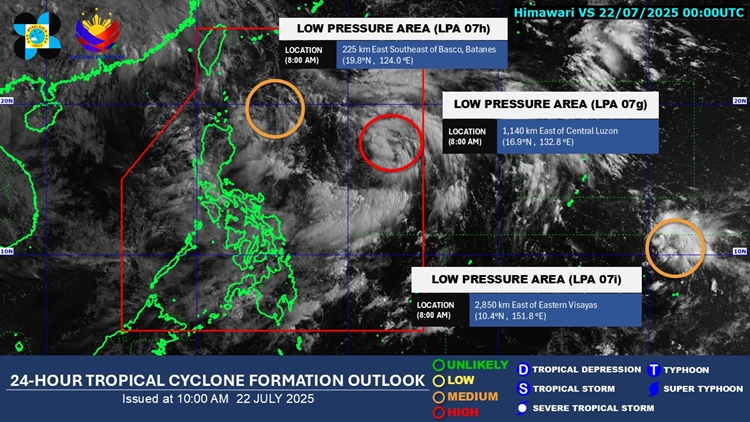3 LPAs Being Monitored by PAGASA Inside and Outside PAR
PAGASA – The state weather bureau is currently monitoring three low-pressure areas (LPAs) located both inside and outside the Philippine Area of Responsibility (PAR), according to its latest report released Tuesday, July 22.
One of the LPAs, identified as LPA 07g, is located approximately 1,140 kilometers east of Central Luzon. According to PAGASA, this system now has a high chance of developing into a tropical depression within the next 24 hours. Another system, LPA 07h, was spotted about 225 kilometers east-southeast of Basco, Batanes. This LPA still has a medium chance of intensifying into a tropical depression within the same period.
In addition to these two weather disturbances inside PAR, PAGASA is also monitoring a new low-pressure area located outside PAR, about 2,850 kilometers east of Eastern Visayas. Known as LPA 07i, this weather system also has a medium chance of developing into a tropical depression within the next 24 hours.

PAGASA emphasized that while none of these weather disturbances have developed into stronger storms yet, they are being closely monitored, as they could bring rain and possible weather disruptions if they intensify. Meanwhile, the southwest monsoon, or habagat, continues to affect large parts of Luzon, bringing cloudy skies and scattered rain showers.
The weather bureau advises the public to stay updated by following official forecasts and warnings, as weather conditions can change quickly. Communities, especially those in vulnerable areas, are encouraged to stay alert and prepare for possible heavy rains and localized flooding in the coming days.

Meanwhile, the Philippine Atmospheric, Geophysical and Astronomical Services Administration (PAGASA) is the official weather agency of the Philippines. It monitors the country’s weather, climate, and even space-related conditions.
PAGASA provides daily weather updates, storm warnings, and flood alerts to help keep people safe, especially during typhoons and heavy rains. It also monitors low-pressure areas, earthquakes, and other natural events.
